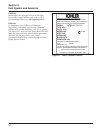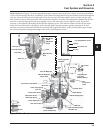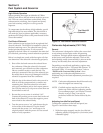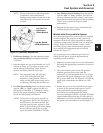
5.4
Section 5
Fuel System and Governor
3. Remove the pulse line that connects the pump to
the crankcase.
4. Install a new pump using the hex flange screws.
NOTE: Make sure the orientation of the new
pump is consistent with the removed
pump. Internal damage may occur if
installed incorrectly.
5. Connect the pulse line between the pump and
crankcase.
6. Torque the hex flange screws to 2.3 N·m
(20 in. lb.).
7. Connect the fuel lines to the inlet and outlet
fittings.
Carburetor
General
CV17-740 engines in this series are equipped with
either a Nikki or Keihin one-barrel, fixed main jet
carburetor. Some applications use a fuel shut-off
solenoid installed in place of the fuel bowl retaining
screw, and also an accelerator pump. All carburetors
feature a self-relieving choke like or similar to the one
shown in the exploded view on page 5.12. These
carburetors include three main circuits, which
function as described following. CV750 engines use a
Keihin BK two-barrel carburetor on a matching intake
manifold. This carburetor with related servicing and
adjustments is covered beginning on page 5.20.
CV17-740 Engines
Float Circuit: The fuel level in the bowl is maintained
by the float and fuel inlet needle. The buoyant force of
the float stops fuel flow when the engine is at rest.
When fuel is being consumed, the float will drop and
fuel pressure will push the inlet needle away from the
seat, allowing more fuel to enter the bowl. When
demand ceases, the buoyant force of the float will
again overcome the fuel pressure and stop the flow.
Figure 5-2. Pulse Pump Connections.
Performance
Minimum fuel delivery rate must be 7.5 L/hr. (2 gal./
hr.) with a pressure at 0.3 psi and a fuel lift of 24 in. A
1.3 L/hr. (0.34 gal./hr.) fuel rate must be maintained at
5 Hz.
Replacing the Fuel Pump
Replacement pumps are available through your
source of supply. To replace the pulse pump follow
these steps. Note orientation of pump before
removing.
1. Disconnect the fuel lines from the inlet and outlet
fittings.
2. Remove the hex flange screws (securing pump)
and fuel pump.
Pulse Line
Outlet Line (to
Carburetor)
Inlet Line
Fuel Pump
General
These engines are equipped with a pulse type fuel
pump. The pumping action is created by the
oscillation of positive and negative pressures within
the crankcase. This pressure is transmitted to the pulse
pump through a rubber hose connected between the
pump and crankcase. The pumping action causes the
diaphragm on the inside of the pump to pull fuel in
on its downward stroke and to push it into the
carburetor on its upward stroke. Two check valves
prevent fuel from going backward through the pump.


















